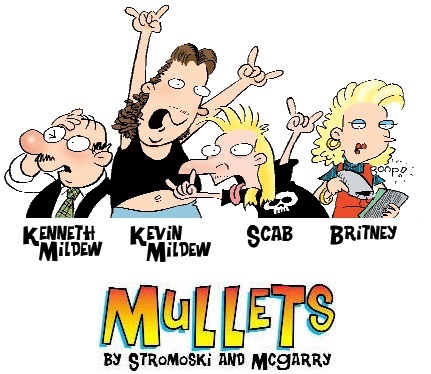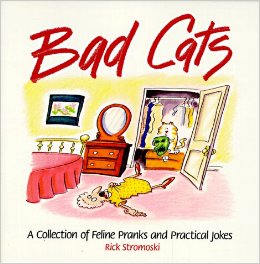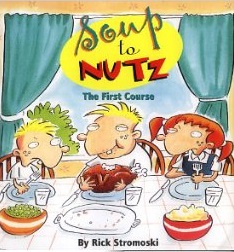 Rick Stromoski is the creator of the popular daily comic strip “Soup to Nutz” and a successful book, magazine and greeting cards illustrator.
Rick Stromoski is the creator of the popular daily comic strip “Soup to Nutz” and a successful book, magazine and greeting cards illustrator.
Rick’s work has appeared in national magazines, children’s and humor books, newspapers, licensed products, national advertising and network television.
Stromoski’s greeting cards have become best-sellers and he has received nominations for the prestigious Louie Award for outstanding greeting card design nine times, winning on four occasions. He has been nominated for his illustration work by the National Cartoonists Society 12 times and was awarded the Reuben division award for best greeting cards in 1995 and 1998, and for magazine gag cartoons in 1999. Elected to the board of the National Cartoonists Society in 1997, he has served as First Vice President and Membership Chairman, and was elected President by the NCS membership in 2005.
The first Soup to Nutz compilation book, Soup to Nutz: The First Course, was published by Andrews McMeel in 2002, while the second one, Soup to Nutz A Second Helping, was published by Soup to Nutz Publications in 2013. Stromoski has illustrated books for MacMillan, Workman, Irena Chalmers, Harcourt Brace Jovanovich, Candlewick Press, McGraw-Hill, Andrews McMeel Publishing, Grolier, Golden Books, Scholastic, Random House and Contemporary Books. He is also an award-winning winemaker, primarily producing German varietals. His wines have won medals including Best of Show in several national and local competitions.
Stromoski, his wife Danna and daughter Molly, along with their dog Rascal and fighting cats Sox and Shoes, live in the historic district of Suffield, Connecticut.
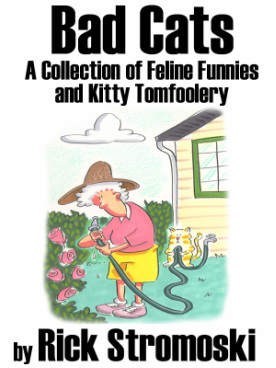 L’IDEA MAGAZINE: Your biography lists various activities in which you are involved: greeting cards design, cartoons, illustrations, and others… Of the first three, which came first and how do they influence each other?
L’IDEA MAGAZINE: Your biography lists various activities in which you are involved: greeting cards design, cartoons, illustrations, and others… Of the first three, which came first and how do they influence each other?
RICK STROMOSKI: I started my career selling single-panel gag cartoons to various magazines: Men’s magazine, women’s magazines, science, animal (pets), religious, Family etc. I realized I was able to transition many of the gags to greeting cards and sold several hundred to many companies. I also began promoting myself as a humorous illustrator since my conceptual skills were honed via writing single-panel gags, many of them captionless. This skill helped me gather work that required encapsulating the gist of an article in a single image. It also paid better.
L’IDEA MAGAZINE: Were you always interested in drawing?
RICK STROMOSKI: I’ve been cartooning since I was a small child…just loved drawing funny pictures…
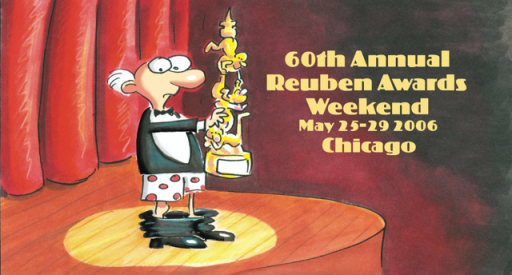
L’IDEA MAGAZINE: You are also an award-winning winemaker. How did that come about, what are the wines you produce, under what label are they sold, and where can they be found?
RICK STROMOSKI: Although it was an amazingly fun and fascinating experience, I no longer make wines. I learned from my father in law Don Gauntner, who has a vineyard in Eastern Pennsylvania. It isn’t a commercial winery, but sells his grapes and juice to commercial wine producers. The bulk of his grapes are reserved for amateur winemakers and he taught several dozen individuals how to produce premium German varietals: Riesling, Gewürztraminer, Traminette, Mueller Thurgau as well as other white wines, such as Sauvignon Blanc, Vidal and Chardonnay. He also grows reds such as Pinot Noir, Chambourcin and Cabernet. My wife Danna and daughter Molly and I would visit the vineyard several times a year at various stages of the winemaking process: harvest, pruning, bottling, etc.
Eastern PA.’s climate is very similar to the wine producing regions of Germany so these wines did very well there. My father in law is the primary American Wine Society’s amateur wine producer in America winning more medals and awards in the past 20 years than any other amateur. His wines and the wines of those who have learned from him win the lion’s share of the medals and awards in every amateur competition they enter. It was a very fun and labor intensive experience for over 15 years and I learned a great deal from a master.
In recent years he’s committed his grapes to commercial producers so I no longer make wine, but maintaining a vineyard is an extreme labor commitment so I don’t blame him for cutting back. He earned the time off. He still produces his own wines for competition and personal consumption.
L’IDEA MAGAZINE: You produced a comic strip named Mullets in the early 90s with Steve McGarry. What kind of arrangement was there between you and Steve? Was the writing a shared function? You are both illustrators; how did you share that job function?
RICK STROMOSKI: Working with Steve was enormously fun. We spoke daily and inevitably we’d both end up in a fit of laughter. Steve did most of the writing and I did the drawing. We’d tweak each other’s work, fine tuning ideas and composition. Steve did the color on Sundays and designed the promotional materials. They say write what you know, so a strip about two idiots was right up our alley. It lasted a year and although very popular where it appeared, failed to garnish enough sales to make it worthwhile.
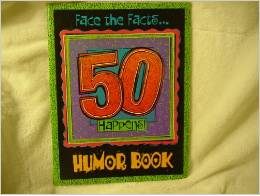 L’IDEA MAGAZINE: You published a few books in the 90s which are not available any more (Madame Wrinkleski Predicts…, 50 Happens! Humor Book, Face The Facts: 40 Happens!, Bad Dogs, Bad Cats, etc…) Were they all born as books or were they collections of single-panel cartoons? Is there any possibility of seeing reprints of those books?
L’IDEA MAGAZINE: You published a few books in the 90s which are not available any more (Madame Wrinkleski Predicts…, 50 Happens! Humor Book, Face The Facts: 40 Happens!, Bad Dogs, Bad Cats, etc…) Were they all born as books or were they collections of single-panel cartoons? Is there any possibility of seeing reprints of those books?
RICK STROMOSKI: Some of these titles were novelty books with Birthday themes 24 or so pages long that had illustrated age related gags…almost glorified Birthday cards. The bad dogs and bad cats books were cartoon collections of captionless gags of dogs and cats doing bad things. I doubt any of the titles will be reprinted, although many of the images in the bad dogs and cats books found new life through licensing, appearing as greeting card lines, calendars, mugs, t-shirts etc. I also resold many of them as gags for cat/dog related magazines.
L’IDEA MAGAZINE: In the two books Bad Cats and Bad Dogs, how much is pure observation of animals and how much is just fantasy?
RICK STROMOSKI: The images reflect the personalities of dogs and cats, but in an anthropomorphic way. Dogs are slightly dumb, cats are devious and aloof; I also touched on the natural animosity between cats and dogs, but exaggerating the situation ie: A cat luring a dog out an open window with a bone tied to a stick.
L’IDEA MAGAZINE: You illustrated many books for other authors. Do you also pitch in with the ideas or they just tell you what kind of illustrations they want? Did you co-write any books?
RICK STROMOSKI: Publishers match me up with authors based on my style that fits with a particular manuscript. I have no input on the text but pretty much free to illustrate as I want. I am given guidelines and suggestions for images, but I also have input on what might work better.
L’IDEA MAGAZINE: Your comic strip Soup To Nutz is around since 2000. Have the characters changed a lot, whether physically or as personality, through the years?
RICK STROMOSKI: Their personalities have pretty much remained the same. Royboy is a boneheaded buffoon, Babs is the intellectual politically correct vegan and Andrew is the kind hearted, sweet Barbie playing Nancy boy. As with most comic strips that have been around for over a decade, physically the characters have changed significantly. One can’t help but evolve one’s drawing style with repetition, you fine tune the line and the characters take on a more consistent look. If you look at Peanuts or the Simpsons, the characters have gone through significant changes from the beginning.

L’IDEA MAGAZINE: Soup To Nutz is extremely popular. I have to confess that I read it every day and I noticed that there really is a feeling of the interaction between siblings that is genuine. How much influence did growing up in a large family have on the content of the strip?
RICK STROMOSKI: Growing up in a family of twelve children has influenced me tremendously. My siblings and the collective experiences are the primary sources of my material. I also draw from my experience as a Dad, but mostly Soup to Nutz is about my family and how we interacted over the years. I remember at every family gathering, whether it be Christmas, Thanksgiving or birthdays, we’d sit around the dining room table and share stories that horrified our parents, they having no idea the things we were up to. Having that many kids in a household lends itself to sheer havoc and lunacy and a wealth of material to draw from. Every one of us has a healthy sense of humor so I’ve yet to run out of ideas after fourteen years.
L’IDEA MAGAZINE: In Soup To Nutz, are the characters from the strip completely fictional or have you used people you know as models?
RICK STROMOSKI: Most of the characters are based on people I’ve known in my life. Some are a pastiche of my siblings and others are based on kids from the neighborhood. Bucky is that kid we all knew who just made up the most fantastic lies about himself and his family, all the while hiding the tragedy that his Dad left him and his Mom when he was a baby. Rosemary is the Tourette girl who spouts nonsense words, spits and shows her affection for Andrew by kicking him in the ankles. Buford is the cousin who flinches a lot and is always afraid when visiting his cousins.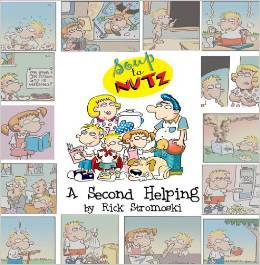
L’IDEA MAGAZINE: What has been your experience with Network Television?
RICK STROMOSKI: I tend to watch cable these days, but will watch CBS and NBC for their sports coverage. I did the cartoons for a CBS television movie comedy starring Jill Clayburgh as a divorcing cartoonist called “Who Gets The Friends”. Jill played a freelance cartoonist who would talk to the camera, relaying the trials of her upcoming divorce while drawing on a sketchpad, table cloth, napkin, garage door etc., and then the camera would focus on the drawing as the scene would bleed into real life. For instance, Jill would be drawing a gorilla playing tennis and it would bleed into James Farentino serving a ball. There were about 15 – 20 of these throughout the movie and I even got a cameo for about 6 seconds. It was a wonderful experience and the easiest $ I ever made in 2 weeks.
L’IDEA MAGAZINE: Are you working on any special projects at this time? What about the near future; any projects in the works?
RICK STROMOSKI: I’ve finished my syndicated strips for all of 2014 so I have a nice cushion that allows me to work on a few projects that have been on the back burner. One being a graphic novel about my late mother. There are a couple of children’s books proposals I’d like to work on as well.
L’IDEA MAGAZINE: You were President of the National Cartoonists Society, and before that you were on the Board of that organization. How hard was the job and what were your duties? Did you find it difficult to juggle that job along with all your other ones?
RICK STROMOSKI: From 1997 to 2014 I’d been an NCS volunteer in some capacity. I was membership Chairman, Awards co-ordinator, 3rd and 2nd VP, President and finally President of the NCS Foundation. It was like a second job, especially around awards time. Duties as membership chairman was to review applications for membership, establish applicants as professionals and co-ordinate with the committee that reviewed potential new members. As awards chairman I co-ordinated instructions to awards juries, answered untold questions from juries and applicants, oversaw the production of the actual awards hardware, actually designed the Gold Key award (Hall of fame) when it was reinstated , designed and issued certificates of nomination to the nominees and mailed out nomination ballots and final ballots to the membership. I’d also have to contact members in arrears with their dues and gently remind them we can’t do what we do without their help. When we roasted one of our luminaries for the saturday night show, for months before hand I would solicit and gather original art from the membership that gently skewered them, have them bound in a portfolio to present to the roastee as a gift from the membership.
As NCS President I would visit potential sites for our Awards weekend for up to 500 members visiting cities and 5 diamond hotels all over the United States. I would plan the convention meeting with hotels negotiating dates, food and beverage prices, accomodations, travel, VIP details, oversee the awards night, seek sponsorship and host several events and parties for sponsors and members. I’d also write a monthly column for the newsletter as well as oversee budgets, income and the organizations finances and investments. At times it felt like herding cats.
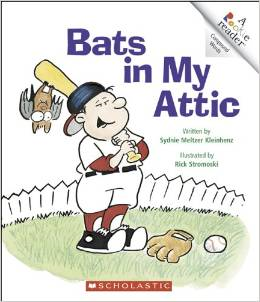 L’IDEA MAGAZINE: What were the comic strips that influenced you the most? Who are the comic strip artists you admire the most and why?
L’IDEA MAGAZINE: What were the comic strips that influenced you the most? Who are the comic strip artists you admire the most and why?
RICK STROMOSKI: I was more influenced by the art and writing of MAD magazine than comic strips due to the variety of creators in every issue. The variety of styles was a big eye opener for me and I learned a lot just from the art in MAD. I loved its irreverance towards popular culture, religion and politics…there were no sacred cows in MAD. I loved Jack Davis’s sports illustrations, Don Martin’s hands and feet, Sergio Aragones’ margin pantomime drawings, Paul Coker’s Horrifying Cliches, Dave Berg’s Lighter side, Al Jaffees foldouts and Mort Drucker’s incredible line and how he captured caricature so effortlessly. It showed me that there were more than one way to draw funny.
If I had to pick comic strips that influenced me I’d have to say I was drawn to the clean lines of Reg Smyth’s Andy Capp and the insanity of Bil Holman’s Smokey Stover… I loved that there was so much else going on in the background’s of Holman’s strip that had nothing to do with the strip idea itself…a picture in the backgound of a sinking ship from one panel to the next, the odd language and the punnish signage…loved it!
L’IDEA MAGAZINE: If you could have any job in the world, no questions asked, what would it be?
RICK STROMOSKI: Exactly what I’m doing now, but I suspect this is a loaded question.
L’IDEA MAGAZINE: Do you have any writers who you would love to illustrate the books for, but you did not have the opportunity to?
RICK STROMOSKI: Not necessarily, but when my daughter was born and I began buying picture books for her, I was particularly drawn to Chris Van Alsberg’s work. His stories were beautifully drawn but they were also just a tad eerie. Both my daughter and I could’t get enough of his work. They always had a moral point to make but did so in a slightly twisted way. I consider him the Rod Serling of childrens books.



